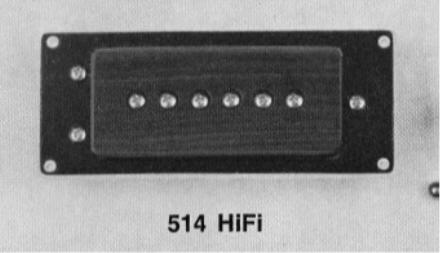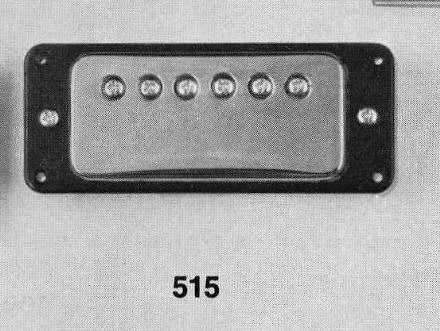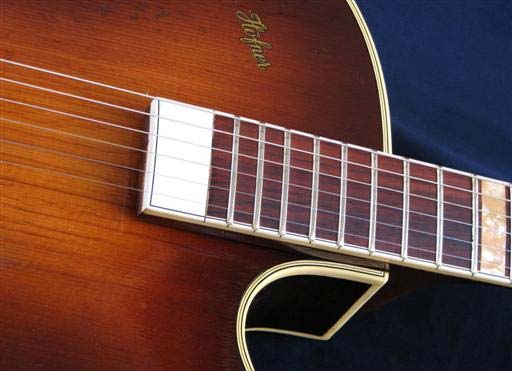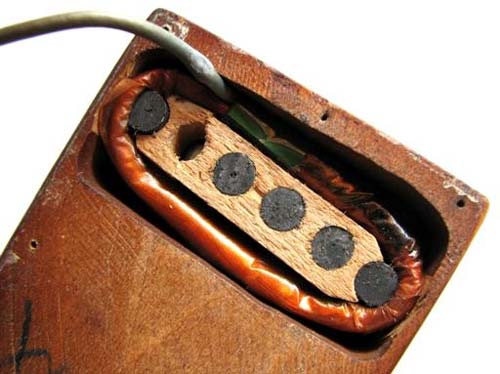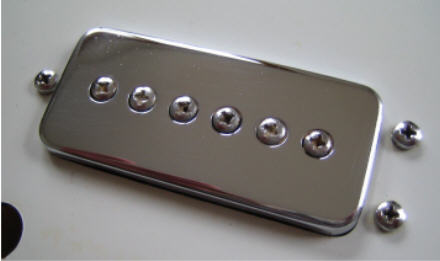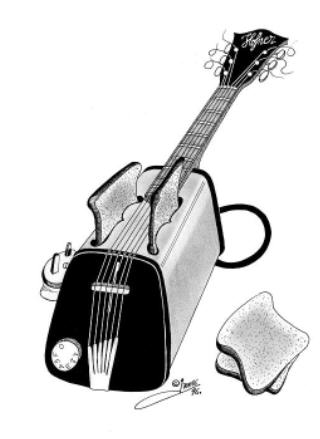

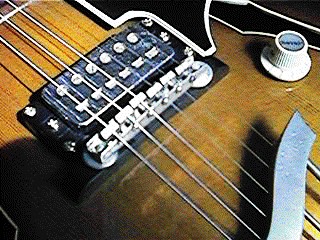
Serial Numbers are the most accurate method of arriving at an
old Hofner's date of manufacture - that is providing it is a Selmer
distributed guitar; the European and US market guitars didn't get
meaningful serial numbers until 1976. Alternatively, many early
archtops have dates of body manufacture written under the table top,
just so as to make it really
difficult to read! You may be able to make an estimate if you can find
dates on the control pots, assuming that they are still the originals
of course, and if so, were fitted to the guitar soon after their own
manufacture. Bear in mind that Hofner made guitar bodies in batches which may
not have been assembled into completed guitars for months and sometimes years!
Likewise, pot codes are not the date at which the guitar was assembled, and
sometimes control consoles remained in parts bins for a long time before being
built into a guitar. All a little tricky if an instant feel for a guitar's age
is required!
The pickups fitted to a Hofner do however add a further dating perspective. Several quite distinct types were fitted
during fairly specific periods across the range of archtops and solids
during the 1950s and 60s, although please bear in mind that whereas the
top-of-the-range guitars and basses usually were fitted with the newest pickups
available, those models at the lower end of the quality range sometimes had to
wait for years before they received the latest pickups.
So.............it's all a question really of looking at all
the evidence, including the pickup type, and making a reasoned estimate. Well, I
never said that it would be easy, did I?
The information given below is provided for general information and identification purposes relating to Hofner pickups only. If you really do wish to strip away the mystery behind pickups in general, then I have no hesitation in recommending the following two articles written by Helmuth Lemme:
The Secrets of Electric Guitar Pickups
Helmuth has also written several books on the
subject of Electric Guitar electronics and sounds which can be viewed on his
(With thanks to Tony Blair for letting me use this picture of his
1955 Hofner 126)
- See further external and internal pictures of this very unusual pickup.
A photo of the internals of a Toaster
pickup, courtesy of Alan Exley of Project Guitar Parts, can be viewed HERE.
c1961: THE DIAMOND LOGO TWIN COIL PICKUP WITHOUT EXPOSED POLEPIECES
(FRANZ PIX MANUFACTURED - TYPE 3) I always thought that these units were single coil, until
I received Brett Brubakers Internal Photos of the Type 3
Pickup. Because of the construction of the Type 510, it should
theoretically be possible to change it to a twin coil humbucker by simply adding
another coil to the existing second set of polepieces. i.e. converting it
into a Type 510 Super, which is described below.
A similar plastic surround and set-screw locating system is used as for the Toaster pickup above. (See attached pictures
of pickup surrounds.)
The Type 510B bass pickup however is a actually a twin-coil unit, very
similar to the Type 3 "Cavern" unit above. It would appear that the
only difference between the Type 510B and the Type 3 is that the 510B has one
set of adjustable poles exposed through the top of the case. The two coils can
be seen in the Project Guitar Parts Photos of the Inside
of a Type 510B.
Just to confuse matters totally, there were apparently also
some Type 510 units that did not have adjustable screw-head polepieces but were
fitted with exposed non-adjustable "staples" instead. See the picture
below of these fairly rare units:
1961-62: THE DIAMOND LOGO "SUPER- SOUND" TWIN COIL HUMBUCKING PICKUP
(MANUFACTURED BY FRANZ PIX - TYPE 511) Picture courtesy of Ton van Passel - The Netherlands
This pickup has two magnets/sets of polepieces plus TWO
coils - i.e. it is a twin coil humbucking pickup. The internal appearance of
the is type of pickup can be clearly seen from Brett Brubaker's photos of
the inside of a Type 511 "Super". See also Project Guitar Parts
photos of the inside of a Type 511 "Super". I suppose that the converse of changing the standard 510
into a humbucker is possible - i.e. the "Super" 511 could always be
changed into a single coil 510 simply by removing a coil. As usual, black plastic surrounds were used with
the side mounted set-screw location system as in the picture above.
Later examples however, had a revised mounting to incorporate Gibson
style height adjustment screws as in the picture at the top of the page.
1967-c1970:
THE TYPE 512 "BLADE" SINGLE COIL PICKUP (MANUFACTURED BY FRANZ PIX) The first of the "Blade" pickups,
this one can be identified from the later 513 6-string unit because it doesn't have a
"notch" in the exposed blade magnet. Both the 512B and 513B
bass pickups don't seem to have had a notch.
These are single coil units (although they
were advertised as having two coils!) with a rather
strange twin magnet arrangement. Brett Brubaker has provided us with photos of
a 512B unit that he has recently re-wound, and his photos
show clearly the internal arrangement. Click HERE
to see the rather interesting construction of the Type 512 Pickup.
Type 512 without notched bar magnet.
From 1969 until the 1990's:
THE TYPE 513 "BLADE" SINGLE COIL
(?) PICKUP (MANUFACTURED BY FRANZ PIX) The longest lasting of all the Hofner standard factory fitted units.
Hofner advertised this type of pickup as having "two
layer-wound magnetic coils and two permanent magnet-systems". With the bass
unit (513B), the catalogue states that "both magnetic coils are especially
dimensioned for perfect re-production of the deep bass frequencies". This
advertising is rather confusing as I can't find anyone who has seen a
"Blade" pickup fitted with two coils! More problamatic is that I
can't find anyone who can tell me what the difference is between the Type
512 and the 512 pickups, other than the notch on the 6-string 513
version.
Type 513 with notched bar magnet. (Note - the
513B Bass pickups didn't have a notch.) It seems that the 513 was not immediately fitted
to all Hofner's range. Only probably the new and top-of-the-range models in
1969 had this pickup fitted initially, but over the next year or two, it
gradually replaced the use of the 512 on the other models. The
six-string units were fitted up to the late 1970's. The use of the bass four-string units continued on the Hofner 500/1 up to the introduction of the
"re-issue" basses in the 1990's. From sometime around the mid-to-late 1970's,
the Hofner logo impressed into the top face of the earlier units was
removed. Bass Guitar Type 513B, without Hofner Logo
(1980's)
THE TYPE 514 AND 515 SPECIALISED PICKUPS
Again in the late 1960's Hofner appear to have introduced two
new pickups for specialised applications on specific high-quality guitars in
their range.
This unit had a wood case, in order to prevent it
from being microphonic. Hofner claimed that "it does not hum or buzz, has
high feedback possibility, and anti-knocking properties. The reproduction is of
excellent naturalness and fidelity." These pickups were fitted on the 174
HiFi and 4579 HiFi Solid guitar models - both of which were Gibson copies
interestingly.
A scan of Hofner's description of the HIFi
Pickups is available HERE
on this website.
The brochure tells us that this pickup was intended for
recording in the studio. It was a twin coil humbucking unit, and Hofner claimed
that it "does not hum, and buzz and is without feedback". It was fitted on several of Hofner's higher quality semis such
as the 4578, 4580, 4700, and 4710, together with the 174 Solid during the early
1970's, and also on the last versions of the Selmer-distributed Senator model.
External and internal photos of a Type
515 supplied by Alan Exley of Project Guitar Parts can be found HERE.
An unusual pickup fitted by Hofner to some of their early
1960's archtops was a crude single coil unit built-in to the end of the
fingerboard. This pickup was disguised under a piece of pearloid, and is shown
in the photograph below:
Hofner also used some unique pickups which seem to have
been chosen on the basis of their appearance in order that they fitted in
with a particular style of guitar. A good example of such a pickup is that
fitted to the Hofner 179 Solid, which was very heavily based on the
appearance of the Fender Jazzmaster:
Since 1978, a variety of Gibson-like pickups have been fitted to Hofner guitars, mostly made by
the German Schaller and Shadow companies.
A Hofner "Toaster", courtesy of Juan Ponte, Spain
(© J. Ponte 2004)
Return to MAIN
HOFNER SITE INDEX PAGE
gitarrenelektronik.de
website.
The main pickup types are listed out below with approximate dates of factory fitting:
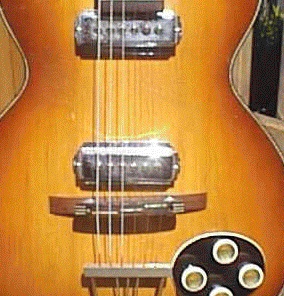
These pickups were manufactured by the German company,
Fuma, and were also sold to other European guitar makers as well as
Hofner. Polepieces were fitted with multi/star slot heads.
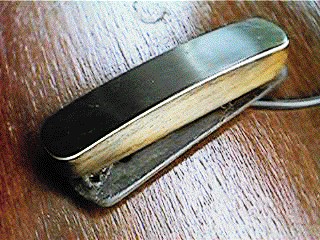
You don't see many wooden bodied pickups these days!!
Two aluminium vertical adjustment wheel on threaded mountings were
originally fitted between the base and main body of the pickup, (see
plastic cased bar pickup below), but unfortunately these are missing
from this example. The centre of the pickup has been hollowed out, and
five bar magnets surrounded by a hand-wound coil are fitted inside. This was the
first pickup designed by Walter Hofner, the father of the Hofner Violin
Bass.

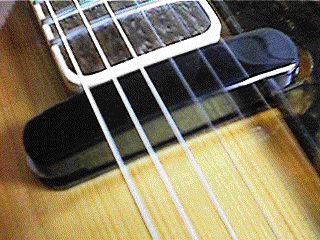
Probably the most desirable pickup with collectors. This
was, after all, the type of pickup fitted to John and Paul's Clubs in
the early Hamburg days, and of course to Stu Sutcliffe's 500/5 Bass! They are of
similar construction to the Rosewood Bar pickups above, apart from the material
used for the case.
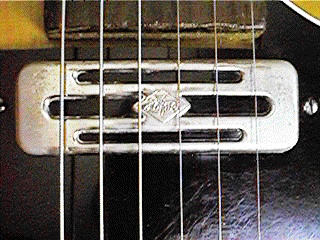
Another type of pickup that has that real Hofner "charm" feel about it. A single coil
pickup,
made by Franz Pix who set up a company in nearby Erlangen specifically to make
electrical fittings for Hofner. The Toaster was again very similar internally to
the previous Rosewood and Black Bar pickups, with five polepiece magnets set in
putty and surrounded by a hand-wound coil. Unfortunately this unit was very short lived.
The picture shows a toaster pickup fitted to a solid guitar. On
archtops, the unit is fitted inside a black plastic surround, and
located with four small set-screws in the ends of the surround which
also are used for adjusting the pickup for height.
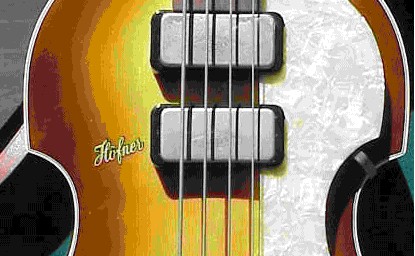
This type was not produced in large numbers, and a Hofner
equipped with Type 3 pickups is fairly rare. It just so happens that Paul
McCartney's first 500/1 Bass had two of them!!
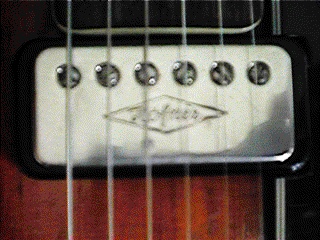
Yeah, I know it's a rhombohedron, but diamond is easier to spell! Looks like a humbucking pickup, but
in the case of the 6-string conventional guitar version, it is actually a single coil unit fitted with two magnets. One line of polepieces
are adjustable and visible. There is another line of polepieces hidden under the
cover. This arrangement can be easily seen using Brett Brubaker's
Photos of
the Inside of a Type 510.
There were also a few exposed polepiece units produced which did not have the diamond logo.
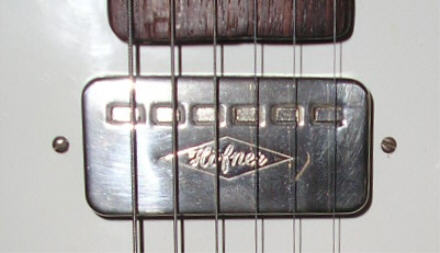
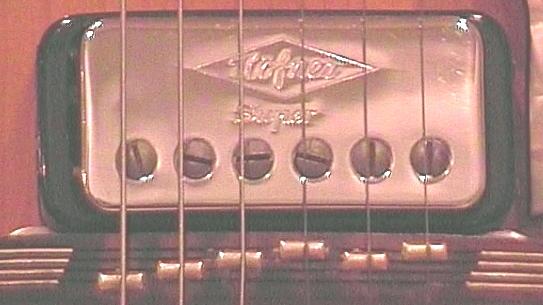
Same appearance as the Type 510, but with
the "Super" logo pressed into the top of the case.
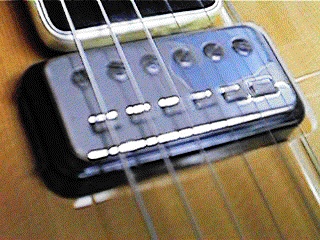
It would appear that he "staple" pickup was simply a
development from the first Type 511 above, and that the only significant difference is
that the non adjustable polepieces ("staples") are now exposed through
the pickup casing.
As an added complication, Hofner introduced a single coil pickup in the
late 1960's, which they also called the 511. This was a single coil unit with
heavy plastic surround. It seems to have been fitted to the Hofner 4500, 4570
and 4572 semi-acoustic guitars, together with the 500/4 bass guitar.
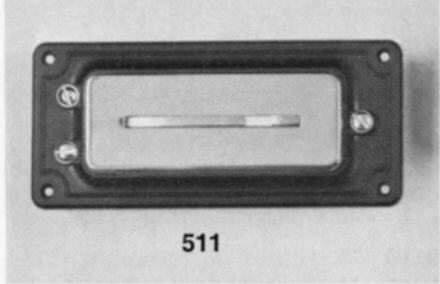
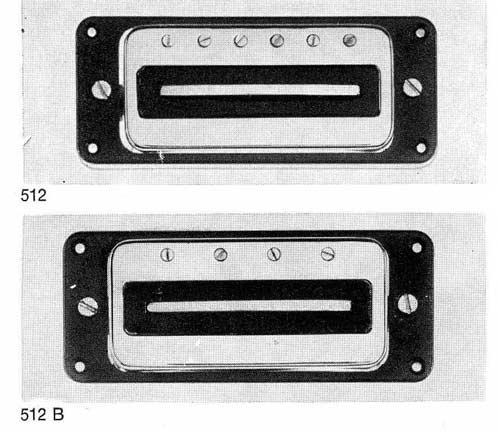
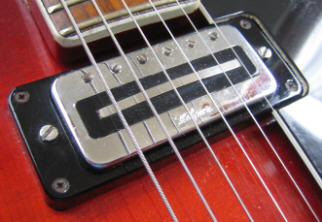
A further complication arises in that
Schaller appear to have begun manufacturing very similar pickups, but of
slightly different dimensions and without the "Hofner" logo from around
1970 for several years. These were actually fitted to some of the WEM-made
"Wilson" guitar models produced during the 1970's. These units are usually
mounted in the Schaller-made plastic pickup mountings shown in the Type
511(iii) photo above.
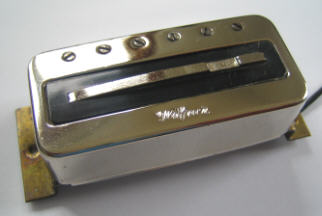
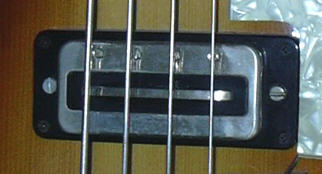
Internal photos of a Type 513B supplied by Alan Exley of Project Guitar Parts can be found
HERE.
